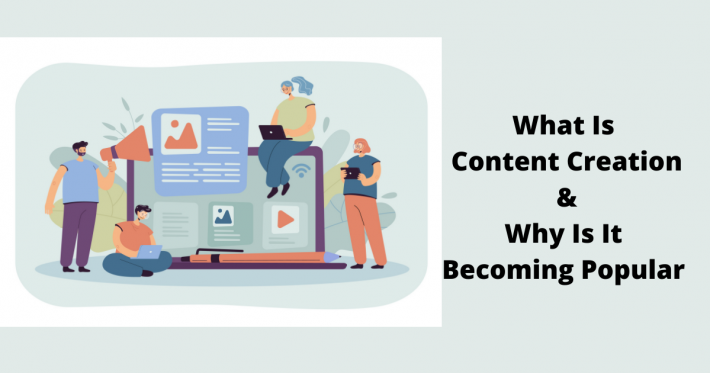“Necessity is the mother of invention” is sure a famous proverb. Do you know what is the necessity is in the digital space? The answer to it is “creation of content”. Every company, business, or website thriving for success online, relies on content creation.


What is Content Creation?
The entire journey from formulating an idea, to making it into a piece of work, and finally publishing it is content creation.
The content is either in written form like articles, blogs, or audio like podcasts, in audiovisuals like videos, or graphics like infographics.
- The one thing that remains common in all such forms of content is “information”. Any content creation leads to connect and convey information to the audience. To convert viewers to a potential audience is the main aim of content creation. The medium to express the content nowadays generally is the internet. That is the reason, almost every piece of content is digital content.
- Why is content creation gaining popularity? Because it is an important part of any brand marketing campaign. It aids in making brand awareness.
- When a business or a company launches a new product, it needs to target the audience to buy it. How to do that? By creating content related to it and putting it out on the internet. It can be a sales copy, a blog, an Instagram reel, or a video.
- Each social media platform demands a different kind of content. Creating such content can advertise the product to the viewers. In such a way, content creators inform the target audience. They through the content can guide them to buy products or services from their company.
- It is the best way to launch something new into the market, build trust amongst the audience. It is also a genuine way to convince them to buy the products.
What Are The Phases Of Content Creation?

The content in any form must have the potential to connect with the audience. Content creation, therefore, needs innovative ideas, an appealing structure that targets the audience.
1. Focus on the goal
Content creators must make a certain set of goals to meet the marketing needs. A plan to achieve the goals stepwise is important or else one can lose focus. Keep the audience in mind while listing the goals.
2. Topic Selection
Choose what are you going to create and the kind of content that you can convey it in. Make yourself clear about the subject you want to create content for. Ask questions to yourself. For eg: “How can the topic interest the audience?”, “Who can be the target audience for such topics?”, etc.
3. Brainstorming
After the form of content and subject to address in your content is clear, it is time to put your thinking cap on! Think of creative ways to create the content. Address the genuine concerns of the audience in the content. Also, think from the audience’s viewpoint.
Jot down all the points and sentences that come to your mind when you think about the topic. It is the most important phase of creating content.


4. Publish
It is the final phase of content creation. After you put all the ideas in the piece of work and do the final formatting and editing, it goes for publishing. Publish it online.
Finally, distribute the content through various social media platforms. It can spread your content and get even more viewers.
Kinds Of Content That Content Creators Make To Target The Audience
Content creators can make written, visual, audiovisual, graphic content. Such content effectively communicates with the audience. It depends upon the skill they own to make the form of content they wish to create. Some of its kinds are as follows:
1. Articles or Blogs

These are forms of content that involve writing. The blog posts when conversational, can influence the audience. They prefer to know more about your website if the blogs you write connect to them.
There are many kinds of blogs. Blogs on the diet, lifestyle, fashion, travel, etc.
2. Videos
Videos are the kind of content that engages the audience to a wide extent. Thereby, driving more traffic to your website.
Explainer videos, product review videos, testimonials, brand videos, etc. are some of its kinds. It highly influences the audience and helps in gaining their trust.
3. Podcasts
These are kinds of audio content. It has become very popular nowadays. People listen to them while driving, free time, or so. Hence, it helps the fast spread of the message.
Podcasts are in many different niches in today’s time. Politics, motivational speeches, authors, fitness, mental health, etc.
4. Infographics
It has become a widely popular kind of graphical representation. It describes charts, graphs, and such important data. It contains both graphical and written elements that inform viewers about the facts. Such facts through infographics are available in an easy format.
5. Social Media Posts
Posting the content on various platforms increases online engagement and bags more viewers from social media.
Instagram reels, Facebook posts, and videos, LinkedIn posts, etc. help content creators gain more viewership. Finally, they get more traffic to their website.
6. Emails and Newsletters
Email marketing builds relationships with subscribers. It is the best way to convey to them the upcoming events or services, resolve their concerns, etc.
There are many more kinds of content. Content is evolving day by day and so are the creators. To refine the skills they use tools that help them smoothen the process of content creation.
Let’s have a look at the tools that content creators use for content creation.


List of 13 Tools For Content Creation
1. Soovle
Keyword research is an important part of content creation. In the most initial stages of creating content, creators search for keyword ideas. Soovle gives you keyword ideas from Google, Youtube, Yahoo, Amazon, Bing, etc.
Using such keyword research tools solves SEO purposes.
2. Google Trends
Keyword ideas are not enough. It is also important to know whether the keywords you are about to use are trending or not. Google Trends allows you to do this. It shows a graphical representation of the trends of the terms monthly. You can know the trend regionally and globally as well.
3. Google Keyword Planner
It even becomes important to use different kinds of keywords. Generic, broad match, and long- tail, all kinds of keywords come into use. Google Keyword Planner aids in comparing keywords and generate even more. You can use such keywords in your content and make it SEO-friendly.
4. Google Docs
If you write blog posts and articles, it is the best space to write while drafting or even while editing. Or else, you can use it to jot down the outline of the content. It is easy to use and also easy to share with teammates or groups. You can also put your work in folders and share it with others. Saving the work, editing, sharing, etc is easy with Google Docs.
5. MindMup
MindMup is also a great tool to map your plans for content creation. It helps you brainstorm ideas. You can create a flowchart of your plans and ideas using this tool. You can outline your goals and plans.
At any point, if you feel like modifying, that is possible too. There are different kinds of nodes you can use to visualize the plan of content creation.
6. FocusWriter
Again, a very useful tool for those who create written content. It gives a disturbance-free writing environment. Those who are easily diverted by notifications online can make use of this tool. It can make most of the writing work possible without distractions.
You can add themes, and fonts you like and customize it your way. It also provides spell check errors in your document, if any. You can resume your work from last where you left when you reopen the program again.
7. Portent’s Content Idea Generator
Content creators use this tool for their blog posts, videos, or even podcasts. It gives ideas of captivating titles. You can type the topic to see what ideas Portent’s Content Idea Generator can bring for you. The compelling titles work the best in grabbing the viewer’s attention.
For eg: The topic is Content Marketing. Portent’s Content Idea Generator came up with the title: “The Unconventional Guide To Content Marketing”
The title is attractive and also makes sense. Sometimes you get very different ideas. But when you keep searching, you may find some of the very catchy titles.
8. Hubspot’s Blog Ideas Generator
This tool gives ideas for headlines for blogs. You can enter the nouns that concern the topic and it will generate ideas for the blog’s headlines. If you like to keep such headlines you can insert them.
You can otherwise observe the patterns and style of the headlines. Then, create one yourself through such ideas.
9. Coschedule Headline Analyzer
The headline you create not only should be attractive but also fulfill the SEO needs. For this purpose, you must use this tool.
It helps you see the SEO score, the readability, the use of power words, emotional words, length of the headline, etc.
Such words impact the headlines a great deal. Thus, making the headline compelling and having a good SEO score on it matters!


10. Grammarly
This tool helps you in making corrections on spelling and grammar errors. It is a very vital tool to use. Especially when you edit the articles, blogs. It is even helpful while framing the writing content for videos.
It looks bad when the content you submit is full of grammar and spelling mistakes. It shows the lack of credibility and seriousness of the content creator. So, the use of tools like Grammarly, helps in the final editing phase of the drafts. It makes the writing part free from such errors.
11. Canva
This is a great tool for graphic designs. You can use this tool to create feature images for your blogs, illustrations, videos, presentations, Instagram reels, infographics, and many more.
Content creators, depending upon their work use the free as well as the pro version. It has free to premium pictures. It has graphics, elements, heading fonts, etc.
The drag and drop feature to add and delete images and other elements makes the tool user-friendly.
12. Duplichecker
After you create the content, it is very important to see whether it resembles any other content online or not. For that, many plagiarism tools are available. One of them is Duplichecker. It allows the detection of plagiarism or any similarity. Using this tool, you can any kind of remove plagiarism. Finally, you can publish your original content.
13. Hootsuite
When you finally publish the content on your website, you need to distribute it also. Distribution throughout social media platforms is a way to do it. Social media platforms help the viewership to grow more.
Creating content and publishing it is a content creator’s job. But, distributing it on various platforms can become very overwhelming.
Putting the content on platforms such as Facebook, Pinterest, LinkedIn, Instagram, etc. can be manageable. Hootsuite is a social media marketing tool that manages such posts.
You can schedule the posts in advance on such platforms. The tool’s analytics gauge the engagement and lets you know the performance of each post.


Conclusion
Content creation is an end-user-oriented process. It can at many times put the creator into a dilemma, but they must try to achieve clarity. With the help of such tools, one can get clarity towards the final goal, which is convincing the audience. This is what gives content marketing the ultimately profitable success.

